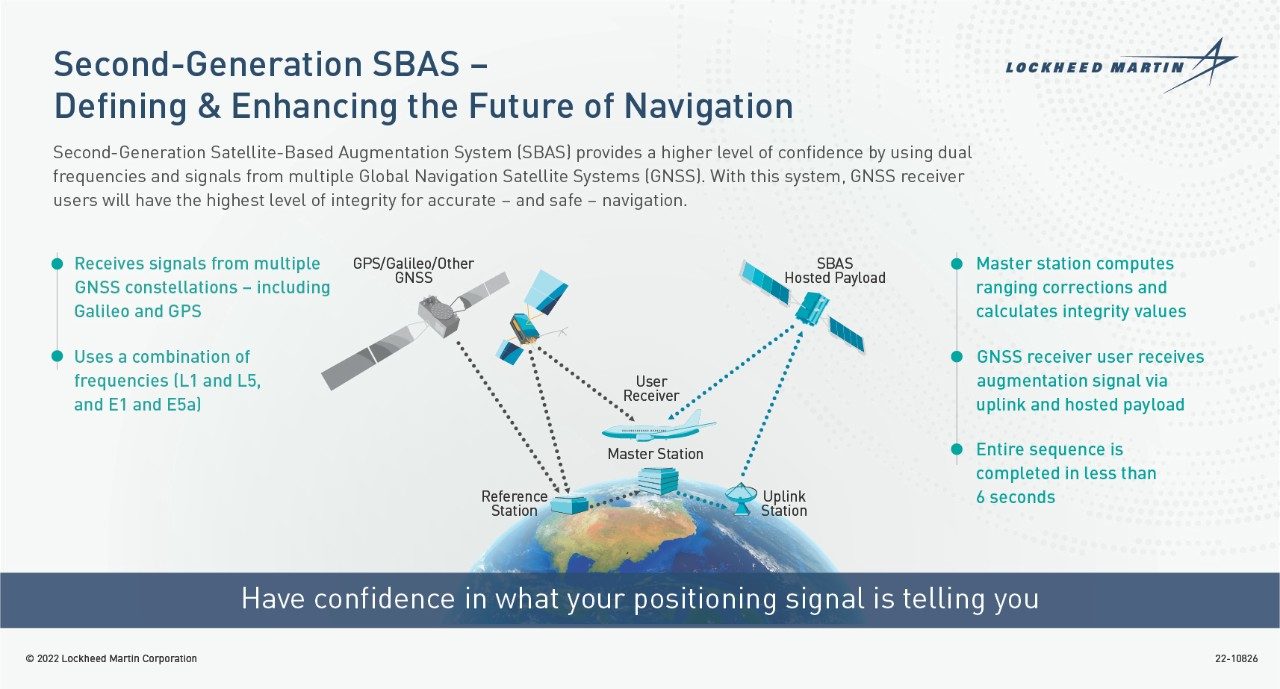Industries in Australia and New Zealand that rely on enhanced precision and safety-of-life navigation and positioning – like airlines, maritime navigation and positive train control – have reason to celebrate.
The government of Australia have awarded Lockheed Martin a $1.18 billion contract to establish the Southern Positioning Augmentation Network (SouthPAN) to enhance precision. The system is expected to be fully operational by 2028, and will be provided as a service for 19 years with an option to extend.
The program will use a unique, Lockheed Martin-developed, Second-Generation Satellite-Based Augmentation System (SBAS), broadcasting on two frequencies to augment signals from two Global Navigation Satellite Systems (GNSS), the U.S. Global Positioning System (GPS) and the European Union’s Galileo system.
The SouthPAN contract will expand Lockheed Martin’s investments toward sustainable business growth in Australia. Currently, Lockheed Martin programs support around 4,000 Australian jobs in advanced manufacturing and technology industries. This contract will grow that footprint with additional jobs in at least four States.
What is SBAS?
“I’ve got a GPS signal,” is a common exclamation from the average user of the widely-used satellite based navigation system.
However, certain industries which demand greater “integrity” – an industry term for higher positioning confidence from a GNSS receiver – use terminals capable of receiving both GNSS signals and augmented signals which refine and provide a more precise position.
Several SBAS are already operational around the world including the U.S.’s Wide Area Augmentation System (WAAS), the European Geostationary Navigation Overlay Service (EGNOS) and Japan’s Multi-functional Satellite Augmentation System (MSAS).
However, these systems only augment GPS-like L1 signals.
The Benefits of Second-Generation SBAS
Lockheed Martin’s Second-Generation SBAS broadcasts augmentation messages for Dual Frequencies from Multiple Constellations (DFMC). This means it uses both the L1 and L5 frequencies from the GPS constellation and the E1 and E5a frequencies from the Galileo constellation.
By using dual frequencies and multiple GNSS constellations, second-generation SBAS enhances integrity data and accuracy for industries that need it the most. Using multiple constellations also eliminates dependency on just one GNSS.
Second-Generation SBAS will further be optimized as more E5a and L5-capable Galileo and GPS III/IIIF satellites continue to enhance those constellations. Today, there are 23 of 30 planned E5a-capable Galileo satellites in orbit. Currently there are 17 L5 capable satellites in the GPS constellation. The U.S. Space Force plans launch up to 32 L5-capable GPS III/IIF satellites as part of an overall GPS modernization effort.
Industries expected to ultimately benefit from enhanced safety, productivity, efficiency and innovation include: agriculture, aviation, construction, maritime, mining, rail, road, spatial and utilities.
How Second-Generation SBAS Works
Lockheed Martin tested a Second-Generation SBAS test-bed in partnership with Geoscience Australia in 2017.
Lockheed Martin’s Second-Generation SBAS technology receives and monitors basic signals data from multiple GNSS through widely-distributed reference stations. This data is collected by a SBAS testbed master station, which computes corrections and integrity bounds for each GNSS satellite signal, and generates augmentation messages.
The new messages are sent to an SBAS payload hosted aboard an Inmarsat geostationary Earth orbit satellite via an uplink antenna in Uralla, New South Wales. The Inmarsat satellite rebroadcasts the augmentation messages containing corrections and integrity data to the end users’ GNSS receivers. This whole process takes less than six seconds.
Lockheed Martin provided the systems integration expertise in addition to the Uralla radio frequency uplink; GMV-Spain provided their “magicGNSS” processors; Inmarsat provided the navigation payload hosted on the 4F1 geostationary satellite. The Australia and New Zealand Cooperative Research Centre for Spatial Information coordinated the demonstrator SBAS test-bed SBAS test-bed projects.
Lockheed Martin Experience
Lockheed Martin has significant experience with space-based navigation systems, and Positioning, Navigation and Timing (PNT). The company developed and is producing the U.S. Space Force’s next generation GPS III/IIIF satellites, and produced the long-lasting GPS IIR and IIR-M satellites, in today’s GPS satellite constellation.
It also maintains the GPS Architecture Evolution Plan ground control system, which operates the entire 31-satellite constellation.





